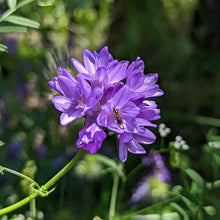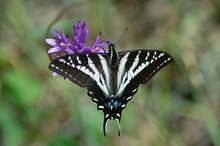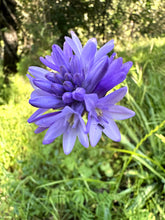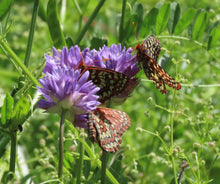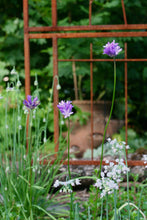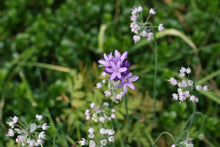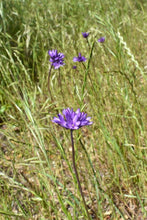
Dichelostemma congestum
**PRODUCT NOTE - These bulbs will be available (in packs of 3) when you pick-up your plants in October. They cannot be pre-ordered since we will not know the total quantity available until the bulbs are dug in September. So, cross your fingers the voles lay off 'em and be sure to look for them at check out in October!
Going by several common names; ookow, field cluster-lily or northern saitas is a fast-growing, delicate wildflower that adds splashes of blue to well-draining sunny areas. Its sparse foliage fits perfectly in dry perennial beds and meadowscapes, where it goes virtually unnoticed until its globe-shaped clusters of bluish-purple flowers seem to suddenly appear, suspended from purple-veined bracts, cheerfully announcing summer.
- Plant type/canopy layer: deciduous, perennial, herbaceous plant
- Size at maturity: 0-24" tall, 0-12" wide
- Light requirements: full sun, part sun/part shade
- Moisture requirements: dry to moist soil, well-drained
- Bloom Time: May - August
- Growth rate/ease: fast growing, easy to grow
- Wildlife support: flowers attract and provide nectar to hummingbirds, adult butterflies, bees, and other insect pollinators
- Native habitat/range: common in meadows, open rocky areas, and open forests, up to 1600m, throughout western Oregon, especially in the Cascades and east Cascades. Portland Plant List - yes.
- Special features & uses: attracts and supports hummingbirds; landscape uses include pollinator gardens and meadowscapes
Gardening with Ookow: This plant is lovely, but diminutive, so we strongly encourage intermixing many individual plants among your dry meadowscapes, pollinator gardens, rock gardens and other perennial beds to add splashes of spring and early summer color. It will thrive in locations that are full sun to light shade and acidic Pacific Northwest soils of any texture (loamy, sandy, etc) as long as it's well-drained.
Planting Instructions:
- Fall Bulbs - Plant in mid to late autumn when the soil temperature is 60°F or colder. Packaged bulbs will appear slightly dried and shriveled, which is completely normal. Plant them 2–3 times deeper than they are high, and space them about twice their diameter apart. Place the bulbs with the pointed side facing up. If you're planting in a container, you can plant the bulbs closer together, but make sure they don't touch. Water well after planting to settle the soil (or save yourself the trouble by planting when the soil is already wet). In the short term, consider placing a physical barrier (like a black plastic flat or the saucer for under a flowerpot) directly on top to deter small mammals from immediately digging it up. Then just sit back and wait for spring.
- Spring Containers - Bulbs are fragile to transplant out of the pot when they're actively growing in spring. So, either plant with care or keep it in its pot and wait until it dies back in mid to late summer before planting. Once it dies back entirely, the bulb will be easy to transplant. If you go this route, leave the pot in a sheltered place and water sparingly, so that you don't rot the bulb.
Photo Credit 1 (close up with insect): © Dominic Gentilcore, some rights reserved (CC-BY)
Photo Credit 2 (with Swallowtail): "Pale Swallowtail on Forktooth Ookow (Dichelostemma congestum) 2014-05-31 (7)" by Don Henise is licensed under CC BY 2.0.
Photo Credit 3 (flower close with ant): © Irina Mitine, some rights reserved (CC-BY)
Photo Credit 4 (with Checkerspot): © icosahedron, some rights reserved (CC-BY)
Photo Credit 5 & 6 (habitat garden with Allium): Karli Del Biondo, Beetles and Bees
Photo Credit 7 (in field): © Gail A Baker, some rights reserved (CC-BY)







